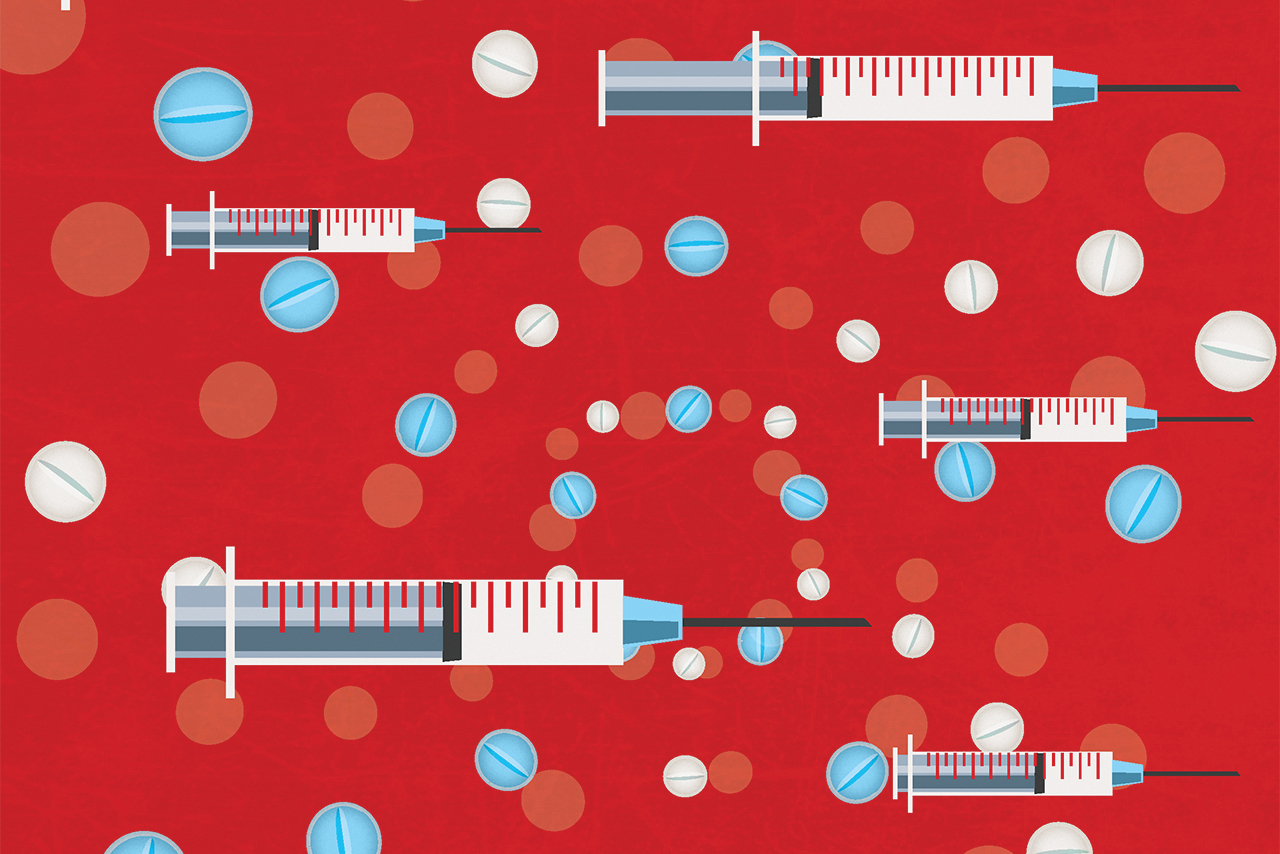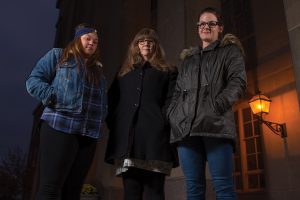Emily O’Connell died bent over the lid of her toilet with a needle in her right hand. A burnt spoon and more needles lay nearby. A lethal combination of heroin and fentanyl killed the 31-year-old on a Sunday evening in November 2016 in her Peoria home. She was engaged, employed, and living less than a mile from Bradley University at the time. Her fiance told investigators O’Connell had stopped using heroin nine months before her fatal overdose.
“She said, ‘One more time.’ One more time was her last time,” said her friend Karen Cassidy, a master’s student in Illinois State’s School of Social Work.
Appears InOne thing about her friend’s death that particularly bothered Cassidy was there were other people inside O’Connell’s home that day. Maybe they could have saved her if they had known what she was doing and had access to naloxone, a medication that reverses opioid overdoses.
Naloxone has become a powerful tool to prevent deaths as the nation’s opioid crisis has spiraled out of control. Opioids are a catchall term for heroin, opiate-based painkillers such as morphine, and synthetic drugs like fentanyl, a vastly more powerful painkiller that can be legally prescribed to cancer patients.
Since 2000, Americans’ ever-increasing abuse of these drugs has led to the overdose deaths of more half a million people across the United States, according to the Centers for Disease Control and Prevention. The problem has become so severe that President Donald Trump even declared the opioid epidemic a national emergency last year.
“Overdoses are through the roof. Why don’t we have Narcan in the hands of the people who need it?” said Cassidy, referring to the brand name of naloxone.
Cassidy has not waited for an answer. She seized an opportunity to deal with the problem through Social Work Associate Professor Cynthia Edmonds-Cady’s course Foundation Social Work Practice: Organizations and Communities.
Each spring semester Edmonds-Cady pairs students in her graduate-level class and has them choose a societal problem they would like to tackle. Then she works with the students to narrow the scope of their projects to something that they can accomplish within their tight time frame and is responsive to what the community’s needs and wants.
Cassidy and classmate Bria Scott created Project Emily, named in memory of O’Connell. For the last year, they have been handing out the life-saving drug naloxone to addicts and the people around them as part of a collaborative effort to counter the onslaught of deadly overdoses in Peoria.
Peoria County had the highest number of fatal opioid overdoses in Central Illinois in 2016: O’Connell was one of 28 victims, according to the Illinois Department of Public Health. McLean County, by comparison, recorded less than half that number of opioid deaths.
Peoria authorities have responded to the surge in drug overdoses by advocating for naloxone and encouraging people to call 911 without fear of arrest, saying without the medication, fatal overdoses would be much higher. Cassidy said Peoria emergency services are responding to two to three overdoses a day, and she has given out an estimated 50 to 75 naloxone kits herself.
Cassidy credited Edmonds-Cady for teaching her to focus on one part of a problem. “I can’t say enough about Cynthia. She just inspires you so that you can make a change.”
Edmonds-Cady is proud of the work project Emily has accomplished, citing the students’ outreach and fundraising prowess. “They are going to be some great, great social workers and great, great citizens. And they already are.”
The goal of the class is to provide the students with real-world experience and critical-thinking and community-building skills they can use as social workers.
Edmonds-Cady coordinates the civic engagement minor and leads a Center for Teaching, Learning, and Technology’s workshop on how professors can redesign their classes with a civic engagement focus. She began developing this social work course and the corresponding “Communities of Practice Model” a decade ago while teaching and studying at Michigan State University with Associate Professor of Social Work Marya Sosulski.
The goal of the class is to provide students with real-world experience and critical-thinking and community-building skills they can use as social workers. Edmonds-Cady hopes the students become more empathetic and engaged in their communities.
“It is helping to shape them to be a better citizen,” Edmonds-Cady said. “I’m clear that the community needs to get something from the students, and the students are obviously getting a lot from the community.”
The students research the community to learn about the sociopolitical and historical contexts of the issue. For example, Cassidy and Scott investigated the factors possibly explaining why the overdose epidemic was hitting Peoria particularly hard.
“They learn a little bit about the social problem and about the community partners they are working with,” Edmonds-Cady said. “Because they are working with the community in a way that is a partnership—rather than saying, ‘I’m an expert, I’m coming to fix you’—the students see the community members as the experts regarding how the social problem is experienced.”
An important aspect of the students’ research is interviewing indigenous experts. These are the activists, nonprofit leaders, and community members dealing with or affected by the issue. This approach teaches the students to enter a community without any preconceived notions.
Cassidy and Scott learned that the nonprofit Jolt Foundation—started by a Peoria doctor whose 16-year-old son died of a heroin overdose—was already distributing naloxone in Peoria, but that there was a gap in serving the homeless community.
Since Cassidy works as a grants officer at the Salvation Army, she and Scott volunteered to conduct trainings and distribute naloxone kits at homeless shelters and on the streets. The pair also established a Facebook page so people could reach out to them directly for naloxone, and held fundraisers to help the Jolt Foundation purchase the medication.
Indigenous experts also played a key role in a different class project. Lana Duran wanted to help the homeless in Bloomington-Normal by offering them free resume preparation and job search services. Instead, she discovered, after interviews with homeless at the Salvation Army’s Safe Harbor shelter, what they really needed: mental health services, specifically clinical therapy. Career services were available to the homeless, but they had only limited access to therapy since they did not have health insurance.
“That was naive of me,” Duran said. “This is their lived experience. I can’t decide what they need.”
Duran’s initial plan was to have therapists provide expanded pro bono therapy at the shelter. That idea was rejected by the shelter due to an existing contract with a therapist.
She conducted further research and learned that therapy dogs can help people who suffer from depression and anxiety. Last fall she started a program to bring therapy dogs to Safe Harbor. She wants to expand on that idea by providing those services at Bloomington Library, where many homeless hang out during the day. Her long-term goal would be to have a social worker stationed at a local library to offer services to the homeless.
Project Emily has also continued its work beyond Edmonds-Cady’s class. The project’s Facebook page still receives messages from people, like a Chicago man who asked to be trained and provided naloxone because he worried about his girlfriend’s heroin addiction. And once a month, Cassidy sets up a table at the Salvation Army near downtown Peoria and offers naloxone trainings.
“Where there is life, there is hope.”
One Friday afternoon last September, a group of nursing students happened to stop by. Cassidy trained them in about 10 minutes on how to inject naloxone—in the “thigh, arm, or butt.” She warned the students to be ready to stand back: The medication immediately reverses the effects of an overdose, causing victims to suddenly wake out of their stupor. They will likely be angry because their high was interrupted and go immediately into withdrawal. Each student received an “Overdose Rescue Kit,” a red bag containing two needles, two vials of naloxone, injection instructions, and a note with Project Emily’s phone number.
Cassidy spent the fall semester conducting an independent study under Edmonds-Cady, examining why some parts of the community resist naloxone and other heroin harm reduction practices such as clean needle exchange programs. Cassidy anticipates and quickly knocks down a common argument against naloxone—she is encouraging addicts to keep using by offering them a safety valve.
She explained how difficult it is to quit using heroin and the highly addictive painkillers. It may take several attempts for an addict to get clean. Therefore, every time someone’s life is saved, there is another chance for that person to get sober. That’s where Project Emily’s motto comes from: “Where there is life, there is hope.”
For more information about Project Emily, visit Facebook.com/projectemily1.
Kevin Bersett can be reached at kdberse@IllinoisState.edu.



I’m a retired social work faculty from the U of I and Univ of Georgia., Edd from I S U. One important thing that I learned at ISU was to develop course objectives to guide your instruction and evaluate it. It is slight jump to use this approach in service learning, with program objectives instead of course objectives.. You may already be doing this. It helps to be able to have a measure of what ou have done.